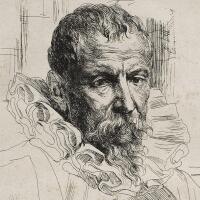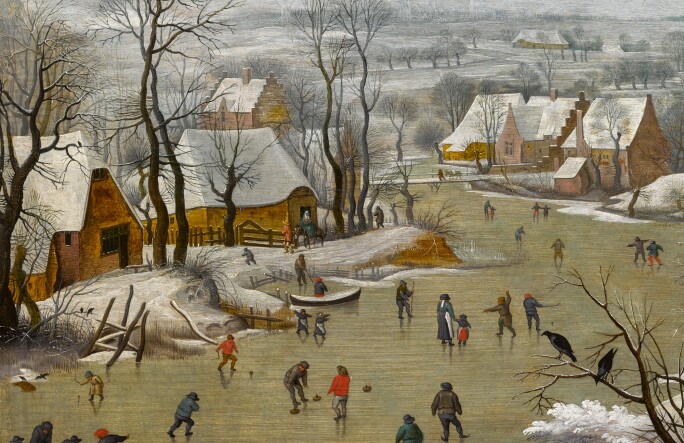T here can be little doubt that the Winter Landscape with a Bird Trap is not only one of the best loved of all the inventions of the Brueghel dynasty, but in its beautiful evocation of a winter’s day also one of the most enduring images in Western art. Although no fewer than 127 versions of the composition have survived, only forty-five are now thought of as autograph works by Pieter Brueghel the Younger himself, with the remainder being largely workshop copies of varying degrees of quality.
The Smith painting is one of only six unmistakably autograph panels which have the distinction of being both signed and dated, with dates ranging from 1601 to 1626. The earliest of the other versions is that now at the Kunsthistorisches Museum in Vienna, and the last that formerly in the Coppée collection in Brussels, sold at Sotheby's, London, 9 July 2014, lot 10.
The prototype for this famous composition has generally been thought to be the painting by Pieter Bruegel the Elder, signed and dated 1564, formerly in the Delporte collection and today in the Musées des Beaux-Arts in Brussels. The near-identical scale and the close correspondence of motifs between the painted copies and the original indicate very strongly that the former must have been based upon Bruegel the Elder's final painted composition, a master cartoon or at least very accurate tracings. The recent appearance of a drawing of the composition, sold at Sotheby's London in 2009 and recently attributed to Jan Brueghel the Elder by Klaus Ertz, would seem to indicate that he too had access to an original painting. The origins of the prototype itself undoubtedly lay in Pieter Bruegel the Elder’s seminal cycle of paintings of the Months, and in particular his celebrated Hunters in the Snow (January) of 1565, today in the Kunsthistorisches Museum in Vienna.
The Winter Landscape with a Bird Trap owes its fame to its extraordinary rendering of the atmosphere of a cold winter’s day. In contrast to the clear and biting cold of the Hunters in the Snow, here the atmosphere is more misty and welcoming. A blanket of deep snow lies upon a riverside village and the surrounding countryside. On the frozen river the villagers are seen playing at spinning tops, hockey and curling on the ice. The muted palette of greys, blues and pale greens is offset by the red costumes worn by many of the participants, a painterly device which harks back directly to Pieter Brueghel the Elder. But perhaps the most distinctive feature of the painting is the graphic and patterned quality of the overlapping branches of the trees and bushes, which serve to create a wonderful decorative effect. The city seen in silhouette on the horizon in the centre is almost certainly intended for Antwerp. As Marlier was the first to observe, one feature of the Smith panel is, however, rare among the many versions of the Bird Trap. This is the inclusion of the figures of man leading a woman upon a donkey on the far bank of the river on the left-hand side of the composition, presumably intended to represent the figures of Joseph and Mary on their way to Bethlehem (see detail of the painting above).
Again, the inclusion of such a small but iconographically significant detail within the larger compositon is very much a device employed by the elder Bruegel. It is not to be found, however, in Pieter Bruegel the Elder’s own painting of 1565 in Brussels, nor any of the many purely workshop copies, and seems to have been an invention of Pieter Brueghel the Younger’s. This very small group also includes the additional motif of a man leading a mule across the bridge in the distance.

That these figures were included in the design from the outset is proven by their appearance in the impressive underdrawing on the panel revealed by infra-red reflectography. It has often been suggested that the Winter Landscape with a Bird Trap, for all its realism, also contains an underlying message alluding to the precariousness of life. In one of his engravings of Winter – Ice skating before St George's Gate, Antwerp, Pieter Bruegel the Elder added the inscription: 'Lubricitas Vitæ Humanæ. La lubricité de la vie humaine. De slibberachtigeyt van’s Menschen Leven' ('The precariousness of Human Life') referring to the ways in which people find themselves 'slipping and sliding through a life whose existence is more slippery and fragile than ice itself'. The eponymous bird trap itself has also, for example, been interpreted as symbolic of the brevity of life, but is much more likely to be a straightforward detail alluding to the need to lay in food for the winter months. Nevertheless, the hole in the ice, or the figures of the two children running heedlessly towards their parents across the ice despite the latter’s warning cries, all clearly point to the dangers inherent even in this idyllic winter scene, and thereby the fickleness and basic uncertainty of life itself.






